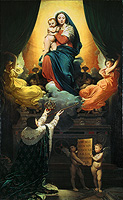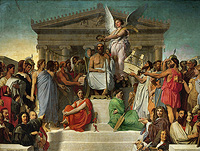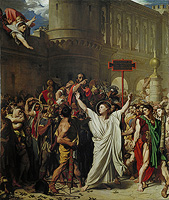
History Paintings
Ingres returned to Paris in November 1824. Influential Parisian artistic circles were campaigning to maintain the ideals of Classicism, and they quietly decided to push Ingres forward as the champion of tradition. He was opposed to the young guard of Romantics and praised for his ability to renew art without destroying it. He exhibited a selection of pictures with "troubadour" themes at the Salon, including The Vow of Louis XIII, a large painting that was commissioned by the cathedral of Montauban.
The Vow of Louis XIII: The sources for this painting are to be found both in the work of Raphael and in the French and Italian Baroque tradition, which Ingres studied in Toulouse. Combining theatricality and realism, Ingres in this picture temporarily left aside his references to Antiquity.
The Apotheosis of Homer: Soon after completing the picture of Louis XIII, Ingres took up the ancient models again with this painting of Homer commissioned for the ceiling of the Louvre. It is a variation on the Classical pattern of The School of Athens painted by Raphael for the Vatican. Ingres conceived this work as a doctrinaire statement of his artistic beliefs. Celebrating Homer, he depicts the poet being crowned while surrounded by a group of artists, writers, poets, musicians, painters and philosophers, who all belong to the Homeric tradition. These are: the great Greek authors and thinkers, Aeschylus, Herodotus, Sophocles, Euripides, Aristotle, Socrates, Plato and Hesiod; a few Roman poets such as Horace and Vergil; the great Classical French writers, Molière, Racine, Corneille, Boileau, La Fontaine, Fénelon; an Englishman, Shakespeare; and finally, two Italians, Dante and Tasso. The fine arts are represented by a much smaller group: Apelles and Phidias illustrate Antiquity; Poussin and Raphael, the modern period. Ingres had originally thought of including David but then decided to leave him out. There are only two musicians: Mozart and Gluck.
The Martyrdom of Saint Symphorian: Ingres worked for nearly ten years on this painting, which was produced for the cathedral of Autun. He made numerous preparatory drawings and oil studies of the composition, the characters and the accessories. Anxious to recreate this event with the greatest historical and archeological accuracy, he even traveled to Autun to study the scene where it took place and the local architecture. Exhibited at the Salon of 1834, the painting was not understood and received with hostility.






